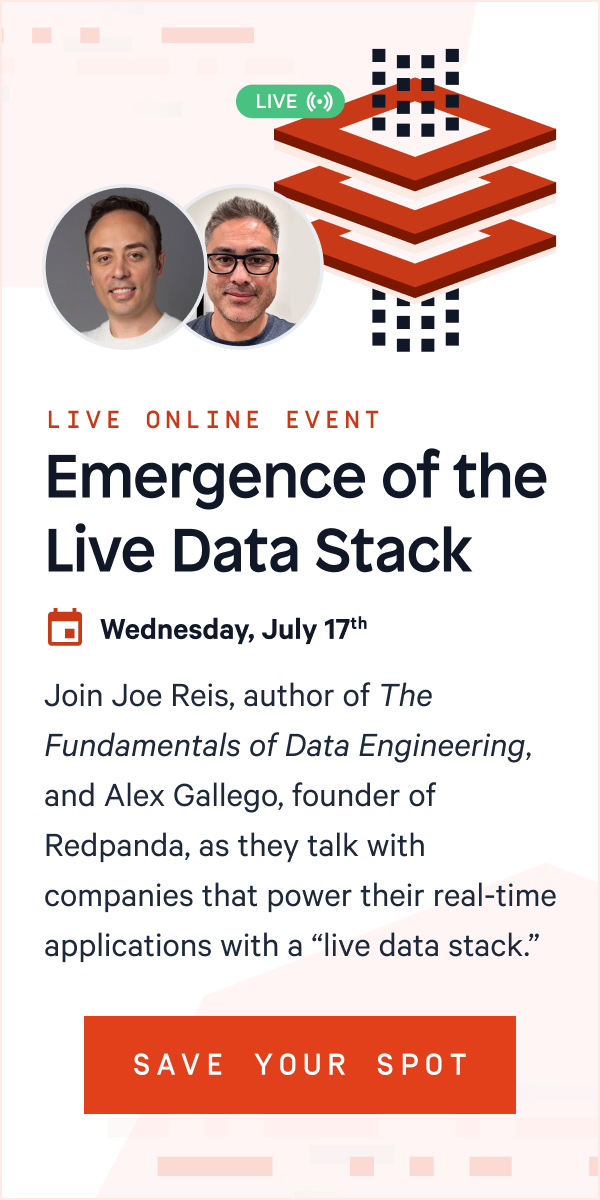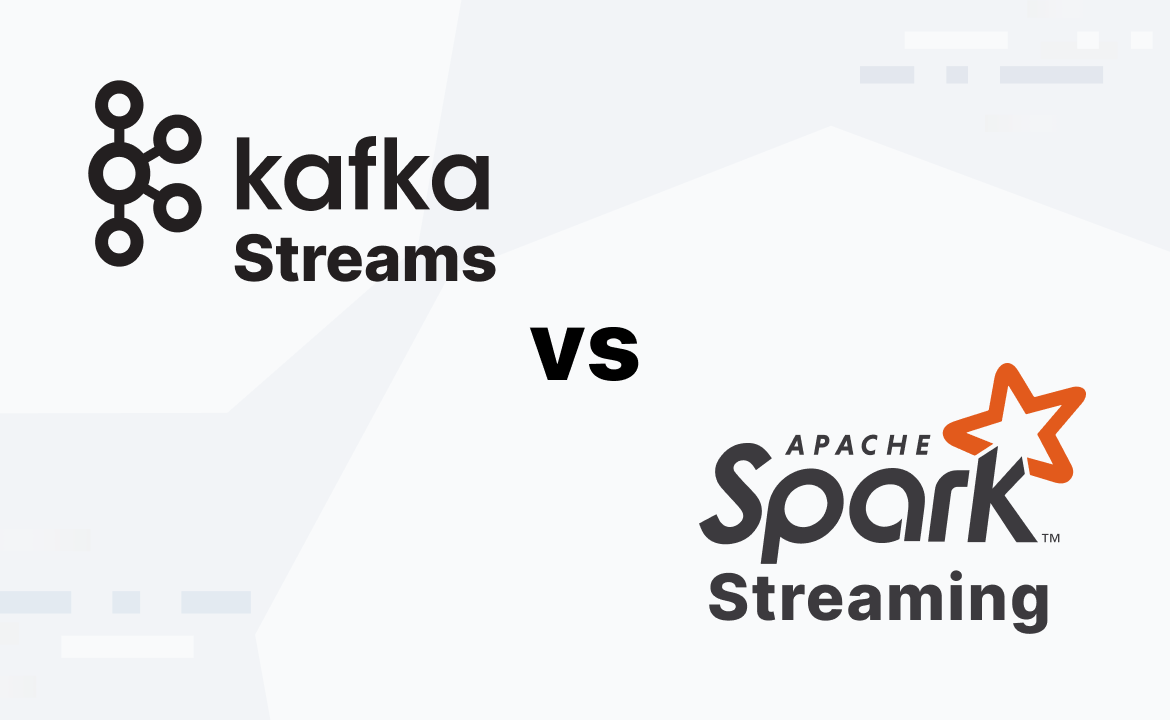Get familiar with the basics of real-time data streaming, how they play together, and how they differ.

When you order an Uber, prompt a large language model, or make any kind of online payment, there they are: streaming data, stream processing, and real-time analytics. Though they’re connected and often play into the same scenarios, they’re not the same.
Unless you’re an experienced real-time data professional, these three key concepts can be hard to tell apart. If you’re only just dipping your toes into the world of real-time streaming data development, you might want to start with our beginner-friendly introduction to streaming data.
In this post, we’ll cover the similarities and differences between streaming data, stream processing, and real-time analytics. We’ll also discuss when you’ll want to choose what. But before that, let’s start with a brief definition of the three key concepts in real-time data:
Streaming data: A continuously generated and processed flow of data, often gathered from numerous data sources. Common use cases are social media timelines, stock market tickers, and IoT monitoring. To manage the neverending data streams, we need a robust and efficient methodology, which is where stream processing comes in.
Stream processing: The engine that keeps real-time applications running smoothly. It deciphers and directs streams of data, breaks them down, and makes sense of them as fast as they come in. Stream processing is particularly useful to businesses when combined with real-time analytics.
Real-time analytics: Extract valuable insights from data as it arrives. This powerful technique fuels fast-paced decision-making processes, so businesses can respond to changing scenarios as they unfold. Real-time analytics can be used to enhance customer experiences, make operations efficient, and even prevent fraud.
Now, let’s take a closer look at each of these real-time concepts. We’ll cover the thinking behind them and their roles in popular use cases. Our goal here is to help you get your concepts straight and set up the best systems for your real-time use case.
Streaming data
They say you can’t step into the same river twice. That’s also very true of data streams since it’s like a constantly flowing river of new data points. Instead of droplets of water, of course, the stream is kept running with the neverending addition of data points – often coming from a myriad of sources.
In today’s world, streaming data is defined by a relentless pace and volume. New drops of data collect in every online game, phone company, and financial institution to form rivers of data. Why is streaming data so important nowadays? In short, timeliness. Since streaming data is processed as it arrives, businesses can make use of it while it’s still fresh.
Streaming data also has its challenges. First and foremost, the immense volume of streaming data can be as overwhelming for both your stack and the team operating it. Data security, reliability, and privacy can also become troublesome with millions of data points across different systems. You need a robust engine to handle the volume, speed, and complexity of streaming data. This is where stream processing comes in.
Stream processing
Stream processing is the net that catches and handles the streaming data. It sorts each data point as quickly as the data flows in, and also extracts valuable information and redirects data to other applications and services.
The main challenges in stream processing include accuracy, scalability, and efficiency. As millions – or even billions – of data points stream every second, stream processing needs to be on point and ready to scale with peaks in streaming data volume.
In most stream processing use cases, the biggest worry is fault tolerance. Any system failure in real-time processing can lead to data loss and disruption of services that are hard to recover from. When implemented correctly, stream processing is an invaluable tool in the world of streaming data. Without it, businesses wouldn’t be able to gain timely insights from their streaming data through real-time analytics. They might still gain insights, but it’ll be too late to act on them.
Real-time analytics
Real-time analytics is where the magic of real-time data happens. In truth, there’s nothing magic to it, but the process of extracting, interpreting, and visualizing real-time data can add some real power to business decisions.
It’s essentially the process of evaluating data in real time (or as it's being collected) and funneling it to the next logical step so users can make timely decisions. The faster you can gain insights from data, the quicker you can act. Whether the data can help optimize a customer experience, stop gas leaks, detect anomalies in IoT systems, alert you of potential payment fraud, or maintain critical infrastructure before it breaks down, there’s a lot of money to be saved—and earned.
Many businesses have preached about being data-driven for years. With the right implementation of real-time analytics, they can live up to those claims and achieve an impressive level of agility. You can also develop custom interactive tools and dashboards to harness those insights to improve the user experience and boost operational efficiency.
Before implementing anything, though, let’s look at the key differences and interconnections between streaming data, stream processing, and real-time analytics.
Streaming data vs. stream processing vs. real-time analytics
Now we’ve looked at streaming data, stream processing, and real-time analytics individually. Let’s bring them together. We’ll imagine them as pieces of a distillery for the sake of clarity.
Streaming data is the raw material. In a distillery, trucks deliver raw materials like malt, water, hops, and yeast in containers. In this real-time factory, we have pipes straight from the sources to our production line. This keeps our raw materials fresh and fed directly to where we need them.
Stream processing is our machinery. Like a production line that processes the ingredients into a beverage, stream processing sorts streaming data to the right places and makes it easy to digest.
Real-time analytics is product design and quality control. The real-time analytics layer takes a hard look at our processed data and gives us the insights we need to make data-driven decisions.
As you see, the three concepts are as deeply connected as they are different. Streaming data is the input stream processing needed to feed real-time analytics. They rely on each other to function. Without streaming data, there’s nothing to process and analyze. Without stream processing, your data just sits there raw and untapped. And without real-time analytics, you’ll never know what insights you’re missing out on.
So it’s very rarely a question of choosing just one of these concepts. You’ll only gain real-time insights by making all three work together in a way that fits your use case.
How to choose the right approach for your real-time development
If you’re new to real-time development, it might feel a bit overwhelming and intimidating to choose a real-time approach. Here are some pointers to help you make the best choice and adjust along the way.
Identify your goal: Are you building a solution for real-time gaming, a scalable backend for a meal-ordering service, or perhaps a real-time chat application? Your end goal will greatly influence your choice of tools.
Know your data: What kinds of data will you be working with? Huge amounts of rapidly incoming comments for sentiment analysis, sensor data for an IoT project, or streaming logs from a web application? High-speed, diverse, and voluminous data might call for robust stream processing mechanisms.
How much speed do you need: Consider how quickly you need to process your data. If you’re building a chat application, for example, you’ll need the messages to move in real time. But some of your data might be just fine arriving with a small delay, so you could use near real-time processing.
Plan for growth: We all know we should think ahead to ease future development and debugging. In real-time development, it’s also important to imagine your application being used by millions of users. Can your chosen tools handle that level of success? Always consider scalability and flexibility right from the start.
Expect the unexpected: Systems fail. When real-time systems do, they can lose data. So you should always make sure your solutions can handle hiccups and minimize data loss.
Think security: Always prioritize security and privacy – especially if you're working with user data. Your reputation and legal compliance depend on it.
Time and money: When you’ve considered the previous points, get ready to adjust them to your actual resources. This includes the cost of the tools you need. But don’t forget the time and effort you need to get familiar with them.
Remember, there’s no single way to approach all real-time development projects. You need to find the pieces that fit your design, and no amount of preparation can help you quite like getting hands-on with streaming data.
Start streaming data right with Redpanda
To recap, streaming data is a continuous flow of information. Stream processing is like a net that helps you catch, sort, and process the data. And then there’s real-time analytics that evaluates the data and the best course of action for them.
However, all of that streaming data has to be ingested somewhere before you can do anything useful with it. Traditionally, a popular point of entry was Apache Kafka®, but in a time of endless real-time data that needs to be processed and analyzed in a blink, you’ll want to use something more modern (and less complex to manage).
Enter Redpanda—the simple, high throughput, and cost-efficient streaming data platform. It’s fully compatible with Kafka-compatible stream processors, designed for speed and operational simplicity, and reliable at any scale. Think Kafka—but faster, more powerful, and simpler in every way.
Ready to roll up your sleeves and get started? You can grab the Redpanda Community Edition on GitHub or try Redpanda Cloud for free. Then go ahead and dive into the Redpanda Blog for examples and step-by-step tutorials. For questions about Redpanda or all things data streaming, chat with the experts in our Redpanda Community on Slack.
Resources
On a roll? Keep learning about real-time streaming data with these great reads:
Let's keep in touch
Subscribe and never miss another blog post, announcement, or community event. We hate spam and will never sell your contact information.





